MKTG Chapters 8-15, 17 – Flashcards
Unlock all answers in this set
Unlock answersquestion
Product
answer
Anything that can be offered to a market for attention, acquisition, use or consumption that might satisfy a want or need
question
Service
answer
An activity, benefit, or satisfaction offered for sale that is essentially intangible and does not result in the ownership of anything
question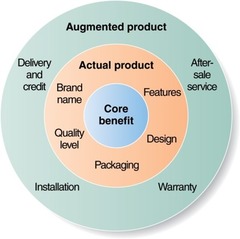
Three Levels of Product

answer
1. Core Customer Value 2. Actual Product 3. Augmented Product
question
Core Customer Value
answer
At the most basic level, the company asks "What is the customer really buying?" -For example, people who buy an iPad are buying more than a tablet computer. They are buying entertainment, self-expression, productivity, and connectivity - a mobile and personal window to the world
question
Actual Product
answer
Includes: -Brand Name -Quality Level -Packaging -Design -Features
question
Augmented Product
answer
Includes: -Delivery and Credit -Product Support -Warranty -After-sale service
question
Consumer Product
answer
A product bought by final consumers for personal consumption -Includes: Convenience products, Shopping products, Specialty products, and Unsought products
question
Industrial Product
answer
A product bought by individuals and organizations for further processing or for use in conducting a business -Includes: Materials and parts, capital items, and supplies and services
question
Convenience Product
answer
A consumer product that customers usually buy frequently, immediately, and with minimal comparison and buying effort -Ex: Fast food, toothpaste, magazines
question
Shopping Product
answer
A consumer product that the customer, in the process of selecting and purchasing, usually compares on such attributes as suitability, quality, price, and style -Ex: Clothing, furniture, major appliances
question
Specialty Product
answer
A consumer product with unique characteristics or brand identification fro which a significant group of buyers is wiling to make a special purchase effort -Ex: Sports cars
question
Unsought Product
answer
A consumer product that the consumer either does not know about or knows about but does not normally consider buying -Ex: Life insurance, preplanned funeral services, blood donations
question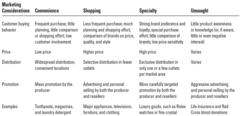
Market Considerations for Consumer Products

answer
Customer buying Behavior, Price, Distribution, Promotion for Each Convenience: -Frequent purchase, little planning or comparison, low customer involvement -Low price -Widespread distribution in convenient locations -Mass promotion by producer Shopping: -Less frequent purchase, much planning and effort, comparison of brands on price, quality, and style -Higher price -Selective distribution in fewer outlets -Advertising and personal selling by both the producer and resellers Specialty: -Strong brand preference and loyalty, special purchase effort, little comparison of brands, low price sensitivity -High price -Exclusive distribution in only one or a few outlets per market area -More carefully targeted promotion by both the producer and resellers Unsought: -Little product awareness or knowledge (or, if aware, little or even negative interest) -Varies -Varies -Aggressive advertising and personal selling by the producer and resellers
question
Organization Marketing
answer
Consists of activities undertaken to create, maintain, or change the attitudes and behavior of target consumers toward an organization
question
Person Marketing
answer
Consists of activities undertaken to create, maintain, or change the attitudes or behavior of target consumers toward particular people
question
Place Marketing
answer
Consists of activities undertaken too create maintain, or change attitudes and behavior toward particular places
question
Social Marketing
answer
The use of commercial marketing concepts and tools in programs designed to influence individuals' behavior to improve their well-being and that of society
question
Individual Product Decisions

answer
1. Product attributes 2. Branding 3. Packaging 4. Labeling 5. Product support services Perry Bought Percy Loving Puppies
question
Product Quality
answer
The characteristics of a product or service that bear on its ability to satisfy stated or implied customer needs -Two dimensions: 1. Performance Quality 2. Conformance Quality
question
Performance Quality
answer
The product's ability to perform its functions
question
Conformance Quality
answer
Freedom from defects and consistency in targeting a level of performance
question
Design
answer
Contributes to a product's usefulness as well as to its looks
question
Brand
answer
A name, term, sign, symbol, or design, or a combination of these, that identifies the products or services of one seller or group of sellers and differentiates them from these competitors
question
Packaging
answer
The activities of designing and producing the container or wrapper for a product
question
Labeling
answer
Range from simple tags attached to products to complex graphics that are part of the packaging -Functions include: 1. Identify the product or brand 2. Describe several things about the product 3. Promote the brand, support its positioning, and connect with customers -Affected by unit pricing, open dating, nutritional labeling
question
Product Line
answer
A group of products that are closely related because they function in a similar manner, are sold to the same customer groups, are marketed through the same types of outlets, or fall within given price ranges -Width: Number of product lines -Length: Number of items in each product line -Depth: Number of versions offered for each product in the product line -Consistency: How closely related the products are to one another
question
Product Width
answer
Number of product lines
question
Product Length
answer
Number of items in each product line
question
Product Depth
answer
Number of versions offered for each product in the product line
question
Product Consistency
answer
How closely related the products are to one another
question
Product Mix (Product Portfolio)
answer
The set of all product lines and items that a particular seller offers for sale
question
Service Intangibility
answer
Services cannot be seen, tasted, felt, heard, or smelled before they are bought
question
Service Inseparability
answer
Services are produced and consumed at the same time and cannot be separate from their providers
question
Service Variability
answer
The quality of services may vary greatly depending on who provides them and when, where, and how they are provided
question
Service Perishability
answer
Services cannot be stored for later sale or use
question
Service Profit Chain
answer
The chain that links service firm profits with employee and customer satisfaction 1. Internal service quality 2. Satisfied and productive service employees 3. Greater service value 4. Satisfied and loyal customers 5. Healthy service profits and growth
question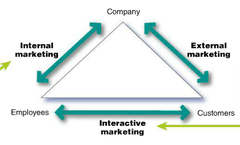
Three Types of Service Marketing

answer
1. Internal Marketing 2. External Marketing 3. Interactive Marketing
question
Internal Marketing
answer
Orienting and motivating customer-contact employees and supporting service employees to work as a team to provide customer satisfaction -Means that the service firm must orient and motivate its customer-contact employees and supporting service people to work as a team to provide customer satisfaction -Must precede external marketing
question
Interactive Marketing
answer
Training service employees in the fine art of interacting with customers to satisfy their needs -Means that service quality depends heavily on the quality of the buyer-seller interaction during the service encounter
question
Managing Service Differentiation
answer
Creates a competitive advantage -Offer -Delivery -Image
question
Managing Service Quality
answer
Enables a service firm to differentiate itself by delivering consistently higher quality than its competitors provide
question
Managing Service Productivity
answer
Refers to the cost side of marketing strategies for service firms -Employe hiring and training -Service quantity and quality
question
Major Brand Strategy Decisions

answer
1. Brand Positioning (Attributes, benefits, beliefs and values) 2. Brand Name Selection (Selection, protection) 3. Brand Sponsorship (Manufacturer's brand, private brand, licensing, co-branding) 4. Brand Development (Line extensions, brand extensions, multi brands, new brands) People Need Some Dogs
question
Brand Equity
answer
The differential effect that knowing the brand name has on customer response to the product or its marketing
question
Brand Value
answer
The total financial value of a brand
question
Store Brand (Private Brand)
answer
A brand created and owned by a reseller of a product or service
question
Co-Branding
answer
The practice of using the established brand name of two different companies on the same product
question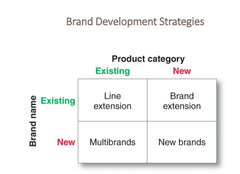
Brand Development

answer
1. Line Extensions 2. Brand Extensions 3. Multibrands 4. New Brands
question
Line Extension
answer
Extending an existing brand name to new forms, colors, sizes, ingredients, or flavors of an existing product category
question
Brand Extension
answer
Extending an existing brand name to new product categories
question
Crowdsourcing
answer
Inviting broad communities of people - customers, employees, independent scientists and researchers, and even the public at large - into the new product innovation process
question
Product Concept
answer
A detailed version of the new product idea stated in meaningful consumer terms
question
New Product Development

answer
The development of original products, product improvements, product modifications, and new brands through the firm's own product development efforts 1. Idea Generation 2. Idea Screening 3. Concept development and testing 4. Marketing strategy development 5. Business analysis 6. Product development 7. Test marketing 8. Commercialization If I Could Make Blueberry Pancakes That's Cool
question
Idea Generation
answer
The systematic search for new product ideas
question
Idea Screening
answer
Screening new product ideas to spot good ones and drop poor ones as soon as possible
question
Concept Testing
answer
Testing new product concepts with a group of target consumers to find out if the concepts have strong consumer appeal
question
Marketing Strategy Development
answer
Designing an initial marketing strategy for a new product based on the product concept
question
Business Analysis
answer
A review of the sales, costs, and profit projections for a new product to find out whether these factors satisfy the company's objectives
question
Product Development
answer
Developing the product concept into a physical product to ensure that the product idea can be turned into a workable market offering
question
Test Marketing
answer
The stage of new product development in which the product and its proposed marketing program are tested in realistic market settings
question
Commercialization
answer
Introducing a new product into the market
question
Marketing Strategy Statement
answer
Consists of: -Target market description -Value proposition planned -Sales, market share, and marketing mix
question
Customer-Centered New Product Development
answer
New product development that focuses on finding new ways to solve customer problems and create more customer-satisfying experiences
question
Team-Based New Product Development
answer
New product development in which various company departments work closely together, overlapping the steps in the product development process to save time and increase effectiveness
question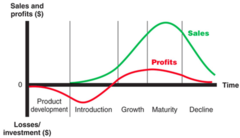
Product Life Cycle (PLC)

answer
The course of a product's sales and profits over its lifetime 1. Product Development (Sales are 0 and the company's investment costs mount) 2. Introduction 3. Growth 4. Maturity 5. Decline People In Guam Marry Dimes
question
Introduction
answer
PLC stage in which a new product is first distributed and made available for purchase -Low sales growth with nonexistent profits
question
Growth
answer
PLC stage in which a product's sales and profits start rising
question
Maturity
answer
PLC stage in which a product's sales growth and profits slows or levels off
question
Decline
answer
PLC stage in which a product's sales and profits fades away
question
Style
answer
A basic and distinctive mode of expression -Describes the appearance of the product
question
Fashion
answer
A currently accepted or popular style in a given field
question
Fad
answer
A temporary period of unusually high sales driven by consumer enthusiasm and immediate product or brand popularity
question
Price
answer
The amount of money charged for a product or service, or the sum of the values that customers exchange for the benefits of having or using the product or service
question
Customer Value-Based Pricing
answer
Setting price based on buyers' perceptions of value rather than on the seller's cost
question
Considerations in Setting Price

answer
-Product Costs: Price floor - no profits below this price -Competition and other external factors: Competitors' strategies and prices, marketing strategy, objectives and mix, nature of the market and demand -Consumer Perceptions of value: Price ceiling - no demand above this price -If customers perceive that a product's price is greater than its value, they won't buy it. If the company prices the product below its costs, profits will suffer. Between the two extremes, the "right" pricing strategy is one that delivers both value to the customer and profits to the company
question
Cost-Based Pricing
answer
Setting prices based on the costs of producing, distributing, and selling the product plus a fair rate of return for effort and risk 1. Design a good product 2. Determine product costs 3. Set price based on cost 4. Convince buyers of product's value Gary Can Purchase Vat
question
Value-Based Pricing
answer
1. Assess customer needs and value perceptions 2. Set Target Price to match customer perceived value 3. Determine costs that can be incurred 4. Design product to deliver desired value at target price Nicole TP'd Carly's Dock
question
Good-Value Pricing
answer
Offering just the right combination of quality and good service at a fair price
question
Everyday Low Pricing (EDLP)
answer
Involves charging a constant everyday low price with few or no temporary price discounts
question
High-Low Pricing
answer
Involves charging higher prices on an everyday basis but running frequent promotions to lower prices temporarily on selected items
question
Value-Added Pricing
answer
Attaching value-added features and services to differentiate a company's offers and charging higher prices
question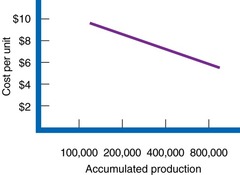
Experience Curve (Learning Curve)

answer
The drop in the average per-unit production cost that comes with accumulated production experience
question
Cost-Plus Pricing (Markup Pricing)
answer
Adding a standard markup to the cost of the product -Markup Price = Unit Cost / (1 - Desired Return on Sales )
question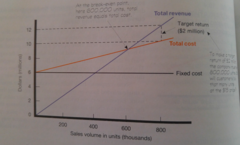
Break-Even Pricing (Target Return Pricing)

answer
Setting price to break even on the costs of making and marketing a product, or setting price to make a target return -Break-Even Volume = Fixed Cost / (Price - Variable Cost)
question
Competition-Based Pricing
answer
Setting prices based on competitors' strategies, prices, costs, and market offerings
question
Target Costing
answer
Pricing that starts with an ideal selling price, then targets costs that will ensure that the price is met
question
Demand Curve
answer
A curve that shows the number of units the market will buy in a given time period, at different prices that might be charged
question
Price Elasticity
answer
A measure of the sensitivity of demand to changes in price
question
Market-Skimming Pricing (Price Skimming)
answer
Setting a high price for a new product to skim maximum revenues layer by layer from the segments willing to pay the high price -The company makes fewer but more profitable sales
question
Market-Penetration Pricing
answer
Setting a low price for a new product in order to attract a large number of buyers and a large market share
question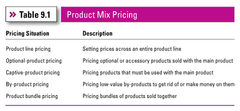
Product Mix Pricing

answer
-Product line pricing: Setting prices across an entire product line -Optional product pricing: Pricing optional or accessory products sold with the main product -Captive product pricing: Pricing products that must be use with the main product -By product pricing: Pricing low value by products to get rid of or make money on them -Product bundle pricing: Pricing bundles of products sold together
question
Product Line Pricing
answer
Setting the price steps between various products in a product line based on cost differences between the products, customer evaluations of different features, and competitors' prices
question
Optional-Product Pricing
answer
The pricing of optional or accessory products along with a main product
question
Captive-Product Pricing
answer
Setting a price for products that must be used along with a man product, such as blades for a razor and games for a video game console
question
By-Product Pricing
answer
Setting a price for by-products in order to make the main product's price more competitive
question
Product Bundle Pricing
answer
Combining several products and offering the bundle at a reduced price
question
Discount
answer
A straight reduction in price on purchases during a stated period of time or of larger quantities
question
Allowance
answer
Promotional money paid by manufacturers to retailers in return for an agreement to feature the manufacturer's products in some way
question
Promotional Allowances
answer
Payments or price reductions that reward dealers for participating in advertising and sales-support programs
question
Segmented Pricing
answer
Selling a product or service at two or more prices, where the difference in prices is not based on differences in costs
question
Psychological Pricing
answer
Pricing that considers the psychology of prices and not simply the economics -The price is used to say something about the product
question
Promotional Pricing
answer
Temporarily pricing products below the list price, and sometimes even below cost, to increase short-run sales
question
Geographical Pricing
answer
Setting prices for customers located in different parts of the country or world
question
Dynamic Pricing
answer
Adjusting prices continually to meet the characteristics and needs of individual customers and situations
question
International Pricing
answer
Adjusting prices for international markets
question
Reference Prices
answer
Prices that buyers carry in their minds and refer to when they look at a given product
question
FOB-Origin Pricing
answer
A geographical pricing strategy in which goods are placed free on board a carrier -The customer pays the freight from the factory to the destination
question
Uniform-Delivered Pricing
answer
A geographical pricing strategy in which the company charges the same price plus freight to all customers, regardless of their location
question
Zone Pricing
answer
A geographical pricing strategy in which the company sets up two or more zones -All customers within a zone pay the same total price -The more distant the zone, the higher the price
question
Basing-Point Pricing
answer
A geographical pricing strategy in which the seller designates some city as a basing point and charges all customers the freight cost from that city to the customer
question
Freight-Absorption Pricing
answer
A geographical pricing strategy in which the seller absorbs all or part of the freight charges in order to get the desired business
question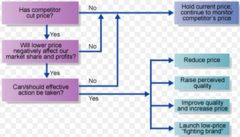
Responding to Competitor Price Changes

answer
-It can reduce its price to match the competitor's price -The company might maintain its price but raise the perceived value of its offer -The company might improve quality and increase price, moving its brand into a higher price value position -The company might launch a low price "fighter brand"
question
Public Policy Issues in Pricing

answer
-Federal legislation on price-fixing states that sellers must set prices without talking to competitors -Sellers are also prohibited from using predatory pricing (selling below cost with the intention of punishing a competitor or gaining higher long-run profits by putting competitors out of business)
question
Upstream Partners
answer
Firms that supply raw materials, components, parts, information, finances, and expertise needed to create a product or service
question
Downstream Partners
answer
Include the marketing channels or distribution channels that look toward the customer, including retailers and wholesalers
question
Value Delivery Network
answer
A network composed of the company, suppliers, distributors, and, ultimately, customers who partner with each other to improve the performance of the entire system in delivering customer value
question
Marketing Channel (Distribution Channel)
answer
A set of interdependent organizations that help make a product or service available for use or consumption by the consumer or business user
question
Channel Level
answer
A layer of intermediaries that performs some work in bringing the product and its ownership closer to the final buyer
question
Direct Marketing Channel
answer
A marketing channel that has no intermediary levels
question
Indirect Marketing Channel
answer
A marketing channel containing one or more intermediary levels
question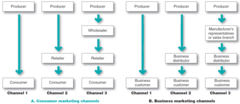
Consumer and Business Marketing Channels

answer
Consumer: Producer to Wholesaler to Retailer to Consumer Business: Producer to Manufacturer's representatives or sales branch to Business distributor to Business customer
question
Channel Conflict
answer
Disagreements among marketing channel members on goals, roles, and rewards - who should do what and for what reward
question
Horizontal Conflict
answer
Occurs among firms at the same level of channel -Ex: Ford dealers in Chicago may complain that other Ford dealers in the city steal sales from them
question
Vertical Conflict
answer
Conflict between different levels of the same channel -Even more common -Ex: McDonald's has recently faced growing conflict with its corps of almost 3,000 independent franchises
question
Conventional Distribution Channel
answer
A channel consisting of one or more independent producers, wholesalers, and retailers, each a separate business seeking to maximize its own profits, perhaps even at the expense of profits for the system as a whole
question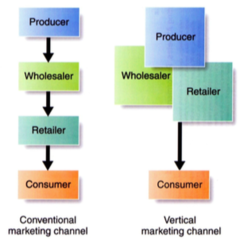
Comparison of Conventional Distribution Channel with Vertical Marketing System

answer
Conventional: Producer to Wholesaler to Retailer to Consumer Vertical: All three together to consumer
question
Vertical Marketing System (VMS)
answer
A channel structure in which producers, wholesalers and retailers act as a unified system -One channel member owns the others, has contracts with them, or has so much power that they are all cooperate
question
Corporate VMS
answer
A vertical marketing system that combines successive stages of production and distribution under single ownership - channel leadership is established through common ownership
question
Contractual VMS
answer
A vertical marketing system in which independent firms at different levels of production and distribution join together through contracts
question
Franchise Organization
answer
A contractual vertical marketing system in which a channel member, called a franchisor, links several stages in the production-distribution process
question
Administered VMS
answer
A vertical marketing system that coordinates successive stages of production and distribution through the size and power of one of the parties
question
Horizontal Marketing System
answer
A channel arrangement in which two or more companies at one level join together to follow a new marketing opportunity
question
Multichannel Distribution System
answer
A distribution system in which a single firm sets up two or more marketing channels to reach one or more customer segments
question
Disintermediation
answer
The cutting out of marketing channel intermediaries by product or service producers or the displacement of traditional resellers by radical new types of intermediaries
question
Marketing Channel Design
answer
Designing effective marketing channels by analyzing customer needs, setting channel objectives, identifying major channel alternatives, and evaluating those alternatives
question
Intensive Distribution
answer
Stocking the product in as many outlets as possible
question
Exclusive Distribution
answer
Giving a limited number of dealers the exclusive right to distribute the company's products in their territories
question
Exclusive Dealing
answer
When the seller requires the the exclusive distribution sellers not handle competitor's products
question
Retail Convergence
answer
Involves the merging of consumers, producers, prices, and retailers, creating greater competition for retailers and greater difficulty differentiating offerings
question
Tying Agreements
answer
Agreements where the dealer must take most or all of the line
question
Selective Distribution
answer
The use of more than one but fewer than all of the intermediaries that are willing to carry out the company's products
question
Marketing Channel Management
answer
Selecting, managing, and motivating individual channel members and evaluating their performance over time
question
Marketing Logistics (Physical Distribution)
answer
Planning, implementing, and controlling the physical flow of materials, final goods, and related information from points of origin to points of consumption to meet customer requirements at a profit -Warehousing, inventory? management, transportation, and logistics information management
question
Supply Chain Management

answer
Managing upstream and downstream value-added flows of materials, final goods, and related information among suppliers, the company, resellers, and final consumers -Suppliers to Company to Resellers to Customers
question
Distribution Center
answer
A large, highly automated warehouse designed to receive goods from various plants and suppliers, take orders, fill them efficiently, and deliver goods to customers as quickly as possible
question
Multimodal Transportation
answer
Combining two or more modes of transportation
question
Integrated Logistics Management
answer
The logistics concept that emphasizes teamwork - both inside the company and among all the marketing channel organizations - to maximize the performance of the entire distribution system
question
Third Party Logistics (3PL) Provider
answer
An independent logistics provider that performs any or all of the functions required to get a client's product to market
question
Retailing
answer
All the activities involved in selling goods or services directly to final consumers for their personal, nonbusiness use
question
Retailer
answer
A business whose sales come primarily from retailing
question
Shopper Marketing
answer
Focusing the entire marketing process on turning shoppers into buyers as they approach the point of sale, whether during in-store, online, or mobile shopping
question
Self-Service Retailers
answer
Serve customers who are willing to perform their own locate-compare-select process to save time or money -The basis of all discount operations and is typically used by retailers selling convenience goods (such as supermarkets) and nationally branded, fast-moving shopping goods (such as Target or Kohl's)
question
Limited-Service Retailers
answer
Provide more sales assistance because they can carry more shopping goods about which customers need information -Their increased operating costs result in higher prices -Sears or JCPenny
question
Full-Serivce Retailers
answer
High-end specialty stores (Tiffany) and first class department stores (Nordstrom or Neiman Marcus) assist customers in every stage of the shopping process -Usually carry more specialty goods for which customers need or want assistance or advice -Provide more services, which results in higher operating costs. These higher costs are passed along to customers as higher prices
question
Major Store Retailer Types
answer
-Specialty Store -Department Store -Supermarket -Convenience Store -Discount Store -Off-Price Retailer -Superstore
question
Specialty Store
answer
A retail store that carries a narrow product line with a deep assortment within that line -Ex: Sephora, Sunglass Hut
question
Department Store
answer
A retail store that carries a wide variety of product lines, each operated as a separate department managed by specialist buyers or merchandisers -Ex: Macy's, Sears, Neiman Marcus
question
Supermarket
answer
A large, low-cost, low-margin, high-volume, self-service store that carries a wide variety of grocery and household products -Ex: Kroger, Safeway, Publix
question
Convenience Store
answer
A small store, located near a residential area, that is open long hours seven days a week and carries a limited line of high-turnover convenience goods -Ex: 7-Eleven
question
Superstore
answer
A store much larger than a regular supermarket that offers a large assortment of routinely purchased food products, nonfood items, and services -Ex: BestBuy, PetSmart, Staples
question
Discount Store
answer
A retail operation that sells standard merchandise at lower prices by accepting lower margins and selling at higher volume -Ex: Walmart, Target, Kohl's
question
Off-Price Retailer
answer
A retailer that buys at less-than-regular wholesale prices and sells at less than retail -TJ Maxx, BJ's -3 types: 1. Independent 2. Factory Outlets 3. Warehouse Clubs
question
Independent Off-Price Retailer
answer
An off-price retailer that is independently owned and operated or a division of a larger retail corporation
question
Factory Outlet
answer
An off-price retailing operation that is owned and operated by a manufacturer and normally carries the manufacturer's surplus, discontinued, or irregular goods
question
Warehouse Club
answer
An off-price retailer that sells a limited selection of brand name grocery items, appliances, clothing, and other goods at deep discounts to members who pay annual membership fees
question
Category Killer
answer
A giant specialty store that carries a very deep assortment of a particular line
question
Service Retailer
answer
A retailer whose product line is actually a service -Ex: Hotels, airlines, banks, colleges
question
Four Major Types of Retail Organizations
answer
1. Corporate Chains 2. Voluntary Chains 3. Retailer Cooperatives 4. Franchise Organizations
question
Corporate Chains
answer
Two or more outlets that are commonly owned and controlled -Ex: Macy's (department stores), Target (discount stores), CVS (drugstores)
question
Voluntary Chain
answer
Wholesaler-sponsored group of independent retailers engaged in group buying and merchandising -Ex: Independent Grocers Alliance, Do-It- Best (hardware), Western Auto (auto supply), True Value (hardware)
question
Retailer Cooperative
answer
Group of independent retailers who jointly establish a central buying organization and conduct joint promotion efforts -Associated Grocers (groceries), Ace Hardware (hardware)
question
Franchise
answer
A contractual association between a manufacturer, wholesaler, or service organization (a franchisor) and independent businesspeople (franchises) who buy the right to own and operate one or more units in the franchise system
question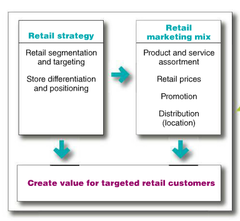
Retailer Marketing Strategies

answer
-Segmentation and Targeting -Store Differentiation and Positioning -Retail Marketing Mix
question
Shopping Center
answer
A group of retail businesses built on a site that is planned, developed, owned, and managed as a unit
question
Showrooming
answer
The shopping practice of coming into retail store showrooms to check out merchandise and prices but instead buying from an online-only rival, sometimes while in the store
question
Wholesaling
answer
All the activities involved in selling goods and services to those buying for resale or business use
question
Wholesaler
answer
A firm engaged primarily in wholesaling activities
question
Wholesalers Add Value By Performing One or More of the Following Channel Functions
answer
-Selling and Promoting (Involves wholesaler's sales force helping the manufacturer reach many small customers at a low cost) -Buying and Assortment Building (Selection of items and building of assortments needed by customers, saving the customers work -Bulk Breaking (Involves the wholesaler buying in large quantities and breaking into smaller lots for customers -Warehousing (Involves the wholesaler holding inventory, reducing its customers' inventory cost and risk) -Transportation (Quick delivery) -Financing (Proving credit and financing suppliers by ordering early and paying on time) -Risk Bearing (Absorbing risk by taking title and bearing the cost of theft, damage, spoilage, and obsolescence) -Market Information (Providing information to suppliers and customers about competitors, new products, and price developments) -Management Services and Advice (Wholesalers helping retailers train their sales clerks, improve store layouts, and set up accounting and inventory control systems)
question
Merchant Wholesaler
answer
An independently owned wholesale business that takes title to the merchandise it handles -Types are: Full-service wholesalers, and Limited-service wholesalers
question
Full-Service Wholesalers
answer
Provide a full line of services: carrying stock, maintaining a sales force, offering credit, making deliveries, and providing management assistance -Full service wholesalers include wholesale merchants and industrial distributors
question
Wholesale Merchants
answer
Sell primarily to retailers and provide a full range of services -General merchandise wholesalers carry several merchandise lines, whereas general line wholesalers carry one or two lines in great depth -Specialty wholesalers specialize in carrying only part of a line
question
Industrial Distributors
answer
Sell to manufacturers rather than to retailers -Provide several services, such as carrying stock, offering credit, and providing delivery -May carry a broad range of merchandise, a general line, or a specialty line
question
Limited-Service Wholesalers
answer
Offer fewer services than full-service wholesalers -Includes: Cash and carry wholesalers, Truck wholesalers, Drop shippers, Rack jobbers, Producers' cooperatives, Mail-order or web wholesalers
question
Brokers
answer
Bring buyers and sellers together and assist in negotiation -Paid by the party who hired the broker and do not carry inventory, get involved in financing, or assume risk -Examples include food brokers, real estate brokers, insurance brokers, and security brokers
question
Agents
answer
Represent either buyers or sellers on a more permanent basis than brokers do -Four types: Manufacturer's agents, selling agents, purchasing agents, commission merchants
question
Manufacturers' and Retailers' Branches and Office
answer
Wholesaling operations conducted by sellers or buyers themselves rather than operating through independent wholesalers -Separate branches and offices can be dedicated to either sales or purchasing
question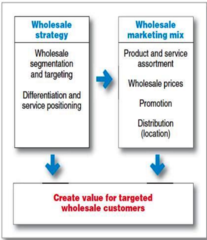
Wholesaler Marketing Strategies

answer
Wholesale strategy: -Wholesale segmentation and targeting -Differentiation and service positioning Wholesale marketing mix: -Product and service assortment -Wholesale prices -Promotion -Distribution (location) -Both of these create value for targeted wholesale customers -Whole sale strategy leads to wholesale marketing mix
question
Promotions Mix (Marketing Communications Mix)
answer
The specific blend of promotion tools that the company uses to persuasively communicate customer value and build customer relationships -Consists of advertising, sales promotion, personal selling, public relations, direct and digital marketing
question
Advertising
answer
Any paid form of nonpersjonal presentation and promotion of ideas, goods, or services by an identified sponsor -Includes: broadcast, print, online, mobile, outdoor, and other forms -Can reach masses of geographically dispersed buyers at a low cost per exposure -Enables the seller to repeat a message many times -Impersonal and lacks the direct persuasiveness of company salespeople
question
Sales Promotion
answer
Short-term incentives to encourage the purchase or sale of a product or a service -Includes: discounts, coupons, displays, and demonstrations -Attracts customer attention -Invite and reward quick response -Can be short lived and often are not as effective as advertising or personal selling in building long run brand preference and customer relationships
question
Personal Selling
answer
Personal presentation by the firm's sales force for the purpose of engaging customers, making sales, and building customer relationships -Includes: sales presentations, trade shows, and incentive programs -Most effective tool -Allows personal relationships -The buyer feels a greater need to listen and respond -Sales force requires a longer term commitment than advertising -Most expensive. Firms spend up to three times as much on personal selling as they do on advertising
question
Public Relations (PR)
answer
Building good relations with the company's various public by obtaining favorable publicity, building up a good corporate image, and handling or heading off unfavorable rumors, stories, and events -Includes: press release, sponsorships, events, and web pages -Very believable, more so than ads -PR can reach prospects who avoid salespeople and advertisements -The message gets to buyers as "news and events" rather than as sales directed communication -PR can dramatize a company or product -Marketers tend to underuse PR, but will a well thought out PR campaign used with other promotion mix elements it can be very effective and economical
question
Steps in Developing Effective Marketing Communication
answer
1. Identify the target audience 2. Determine the communication objective 3. Design the message 4. Choose the media to send the message 5. Select message source and collect feedback
question
Rational Appeal
answer
Relates to the audience's self interest
question
Emotional Appeal
answer
An attempt to stir up positive or negative emotions to motivate a purchase
question
Moral Appeal
answer
Directed to an audience's sense of what is right and proper
question
Direct and Digital Marketing
answer
Engaging directly with carefully targeted individual consumers and customer communities to both obtain an immediate response and build lasting customer relationships -Includes: direct mail, catalogs, online and social media, mobile marketing, and more -Direct marketing is more targeted towards a specific customer or customer commodity -Messages can be prepared quickly and tailored -Interactive: allows a dialogue between the marketing team and the consumer, and messages can be altered depending on the consumer's response -Well suited to highly targeted marketing efforts, creating customer engagement, and building one to one customer relationships
question
New Marketing Communications Model
answer
1. Consumers are changing. They are better informed and more communications empowered. They use the Internet, social media, and other technologies to find out information on his own 2. Marketing strategies are changing. Marketers are shifting away from mass marketing as mass markets have become more fragmented. They are focused on marketing programs designed to build closer relationships with customers in more narrowly defined micromarkets 3. Digital technology advancements are causing changes in the way customers and companies communicate with each other.
question
Content Marketing
answer
Creating, inspiring, and sharing brand messages and conversations with and among customers across a fluid mix of paid, owned, earned, and shared channels
question
Integrated Marketing Communications (IMC)
answer
Carefully integrating and coordinating the company's many communications channels to deliver a clear, consistent, and compelling message about the organization and its products -Carefully blended mix of promotion tools (advertising, personal selling, public relations, sales promotion, direct and digital marketing)
question
Encoding
answer
The process of putting thought into symbolic form -Ex: McDonald's ad agency assembles words, sounds, and illustrations into a TV advertisement that will convey the intended message
question
Decoding
answer
The process by which the receiver assigns meaning to the symbols encoded by the sender -Ex: A consumer watches the McDonald's commercial and interprets the words and images it contains
question
Noise
answer
The unplanned static or distortion during the communication process, which results in the receiver getting a different message than the one the sender sent -Ex: The consumer is distracted while watching the commercial and misses its key points
question
Buyer-Readiness Stages

answer
The stages consumers normally pass through on their way to a purchase 1. Awareness 2. Knowledge 3. Liking 4. Preference 5. Conviction 6. Purchase All Kelseys Like People Called Peter
question
Ideal Message Qualities
answer
-Attention -Interest -Desire -Action (AIDA Method)
question
Personal Communication Channels
answer
Channels through which two or more people communicate directly with each other -Including face to face, on the phone, via email, Internet "chat"
question
Buzz Marketing
answer
Cultivating opinion leaders and getting them to spread information about a product or a service to others in their communities
question
Nonpersonal Communication Channels
answer
Media that carry messages without personal contact or feedback -Including major media, atmospheres, and events
question
Affordable Method
answer
Setting the promotion budget at the level management thinks the company can afford -Small businesses often use this method, reasoning that the company cannot spend more on advertising than it has -They start with total revenues, deduct operating expenses and capital outlays, and then devote some portion of the remaining funds to advertising -This method of setting budgets completely ignores the effects of promotion on sales. It tends to place promotion last among spending priorities, even in situations in which advertising is critical to the firm's success -Can result in overspending on advertising, it more often results in underspending
question
Percentage-of-Sales Method
answer
Setting the promotion budget at a certain percentage of current or forecasted sales or as a percentage of the unit sales price -Simple to use and helps management think about the relationships between promotion spending, selling price, and profit per unit -This method has little to justify it -Wrongly views sales as the cause of promotion rather than as the result -Although studies have found a positive correlation between promotional spending and brand strength, this relationship often turns out to be effect and cause, not cause and effect -Based on the availability of funds rather than on opportunities -May prevent the increased spending sometimes needed to turn around falling sales -Varies with year to year sales, so low range planning is difficult -Does not provide any basis for choosing a specific performance except what has been done in the past or what competitors are doing
question
Competitive-Parity Method
answer
Setting the promotion budget to match competitors' outlays -They monitor competitors' advertising or get industry promotion spending estimates from publications or trade associations and then set their budgets based on the industry average -Two arguments support: 1. Competitors' budgets represent the collective wisdom of the industry 2. Spending what competitors spend helps prevent promotion wars -Neither argument is valid beacuse there are no grounds for believing that the competition has a better idea of what a company should be spending on promotion than does the company itself and also there is no evidence that budgets like that prevent promotion wars
question
Objective-and-Task Method
answer
Developing the promotion budget by: 1. Defining specific promotion objectives 2. Determining the tasks needed to achieve these objectives 3. Estimating the costs of performing these tasks. The sum of these costs is the proposed promotion budget -Advantage of this method is that it forces management to spell out its assumptions about the relationship between dollars spent and promotion results -Most difficult method to use -It is hard to figure out which specific tasks will achieve the stated objectives
question
Push Strategy
answer
A promotion strategy that calls for using the sales force and trade promotion to push the product through channels. -The producer promotes the product to channel members who in turn promote it to final consumers
question
Pull Strategy
answer
A promotion strategy that calls for spending a lot on consumer advertising and promotion to final consumers directly creating a demand vacuum that "pulls" the product through the channel
question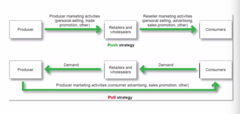
Push Vs. Pull Promotion Strategy

answer
Push Strategy: Producer markets to retailers/wholesalers who market to consumers Pull Strategy: Producer markets to consumers which then creates a demand from the retailers/wholesalers who create a demand from the producer
question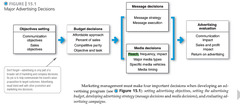
Major Advertising Decisions

answer
Objectives Setting (Communication objectives, sales objectives) to Budget Decisions (Affordable approach, percent of sales, competitive parity, objective and task) to Manage Decisions (Message strategy, message execution)/Media Decisions (Impact and engagement, major media types, specific media vehicles, media timing) to Advertising Evaluation (Communication impact, sales and profit impact, return on advertising)
question
Advertising Objective
answer
A specific communication task to be accomplished with a specific target audience during a specific period of time -Can be classified by their primary purpose: to inform, persuade, or remind
question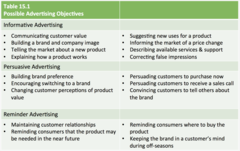
Possible Advertising Objectives

answer
Informative Advertising: -Communicating customer value -Building a brand and company image -Telling the market about a new product -Explaining how a product works -Suggesting new uses for a product -Informing the market of a price change -Describing available services and support -Correcting false impressions Persuasive Advertising: -Building brand preference -Encouraging switching to a brand -Changing customer perceptions of product value -Persuading customers to purchase now -Creating customer engagement -Building brand community Reminder Advertising: -Maintaining customer relationships -Reminding customers that the product may be needed in the near future -Reminding customers where to buy the product -Keeping the brand in a customer's mind during off season
question
Informative Advertising
answer
Used heavily when introducing a new product category -The objective is to build primary demand
question
Persuasive Advertising
answer
Becomes more important as competition increases -The objective is to build selective demand -Some persuasive advertising has become comparative advertising (or attack advertising)
question
Comparative Advertising (Attack Advertising)
answer
A company directly or indirectly compares its brand with one or more other brands -Use with caution because often, such ads invite competitor responses resulting in an advertising war that neither competitor can win
question
Reminder Advertising
answer
Important for mature products -Helps to maintain customer relationships and keep consumers thinking about the product
question
Advertising Budget
answer
The dollars and other resources allocated to a product or a company advertising program -Often depends on its stage in the product life cycle -Market share also impacts the amounts of advertising needed
question
Advertising Strategy
answer
The strategy by which the company accomplishes its advertising objectives -Consists of two major elements: Creating advertising messages and Selecting advertising media
question
Message and Content Strategy
answer
The first step in creating effective advertising content -The general message that will be communicated to consumers -Identifies consumer benefits -Follows from company's broader positioning and customer value creation strategies
question
Madison & Vine
answer
A term that has come to represent the merging of advertising and entertainment in an effort to break through the clutter and create new avenues for reaching customers with more engaging messages
question
Creative Concept
answer
The compelling "big idea" that will bring an advertising message strategy to life in a distinctive and memorable way
question
Execution Styles
answer
The approach, type, tone, words, and format sued for executing an advertising message -Slice of life: Shows one or more "typical" people using the product in a normal setting -Lifestyle: Shows how a product fits in with a particular lifestyle -Fantasy: Creates a fantasy around the product or its use -Mood or Image: Builds a mood or image around the product or service such as beauty, love, pride -Musical: Shows people or cartoon characters singing about the product -Personality Symbol: Creates a character that represents the product -Technical Expertise: Shows the company's expertise in making the product -Scientific Evidence: Presents survey or scientific evidence that the brand is better than others -Testimonial Evidence or Endorsement: Features a highly believable or likable source endorsing the product
question
Advertising Media
answer
The vehicles through which advertising messages are delivered to their intended audience -Steps are: 1. Determining Reach, Frequency, Impact, and Engagement 2. Choosing among major media types 3. Selecting specific media vehicles 4. Choosing media timing
question
Reach
answer
A measure of the percentage of people in the target market who are exposed to the ad campaign during a given period of time
question
Frequency
answer
A measure of how many times the average person in the target market is exposed to the message
question
Impact
answer
The qualitative value of a message exposure through a given medium
question
Engagement
answer
A measure of things such as rating, readership, listenership, and click through rates
question
Profiles of Major Media Types
answer
-Television (Good mass marketing coverage, low cost per exposure, combines sight, sound, and motion, appealing to the senses, high absolute costs, high clutter, fleeting exposure, less audience selectivity) -Digital and Social Media (high selectivity, low cost, immediacy, engagement capabilities, potentially low impact, high audience control of content and exposure) -Newspapers (flexibility, timeliness, good local market coverage, brand acceptability, high believability, short life, poor reproduction quality, small pass along audience) -Direct Mail (high audience selectivity, flexibility, no ad competition within the same medium, allows personalization, relatively high cost per exposure, "junk mail" image) -Magazines (high geographic and demographic selectivity, credibility and prestige, high quality reproduction, long life and good pass along readership, long ad purchase lead time, high cost, no guarantee of position) -Radio (good local acceptance, high geographic and demographic selectivity, low cost, audio only, fleeting exposure, low attention, fragmented audiences) -Outdoor (flexibility, high repeat exposure, low cost, low message competition, good positional selectivity, little audience selectivity, creative limitations)
question
Return on Advertising Investment
answer
The net return on advertising investment divided by the costs of the advertising investment
question
Advertising Agency
answer
A marketing services firm that assist companies in planning, preparing, implementing, and evaluating all or portions of their advertising programs
question
Multichannel Marketing
answer
Marketing both through stores and other traditional offline channels and through digital, online, social media, and mobile channels
question
Forms of Direct and Digital Marketing

answer
Digital and social media marketing (online marketing, web sites, online ads, email, online videos, blogs, mobile marketing, social media marketing) and Traditional direct marketing (face to face, direct mail, catalog, telemarketing, kiosk, direct response TV) both build direct customer engagement and community
question
Marketing Website
answer
A website that engages consumers to move them closer to a direct purchase or other marketing outcome
question
Branded Community Website
answer
A website that presents brand content that engages consumers and creates customer community around a brand
question
Mobile Marketing
answer
Marketing messages, promotions, and other content delivered to on the go consumers through mobile phones, smartphones, tablets, and other mobile devices
question
Direct-Response Television (DRTV) Marketing
answer
Direct marketing via television, including direct-response television advertising (or infomercials) and interactive television (iTV) advertising
question
Public Policy Issues in Direct and Digital Marketing
answer
-Irritation -Unfairness -Deception -Fraud



